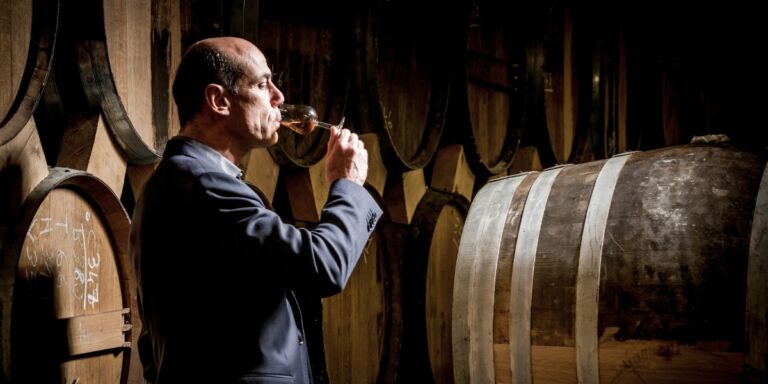Head into any of the world’s best bars right now, order a cocktail and the chances are high that once it arrives, you’ll be able to see straight through it. The rise of clear (and sometimes colourless) cocktails has been exponential over the last decade. And while drinks trends come and go, clarification is playing an increasingly important role for bartenders when creating contemporary cocktails.
At Foco bar in Barcelona, you’ll get a see-through take on rum and Coke, using rum, cola, clarified lime, white port cordial and unripe pear. ‘It’s a drink we crave in certain situations – on the beach, or in a club – but never in a cocktail bar,’ explains co-founder Tom Godfrey, ‘so we created this elevated version to work in either setting.’

For drinkers, the appeal comes from its relative difficulty of replication. ‘It’s still a technique that people don’t do at home, so there is an elusiveness to a cocktail like this,’ says Liana Oster, bar director of Nomad London. ‘It requires a lot of preparation and skill to pull off.’ The hotel has several clarified cocktails on its bar menus: from Common Decency’s Butternut Milk Punch (with bourbon, rum, lemon, squash seeds and strands, and rosso vermouth) to Side Hustle’s carbonated For Pith’s Sake (rye whiskey, Calvados, eau de vie, green apple and cinnamon). ‘There’s something intriguing about looking at a crystal-clear drink knowing that there’s a bank of flavour in there – you can’t tell what’s actually going on inside until you taste it,’ says Oster.
Clear methodology
For anyone still unsure of what clarification means, it is the process of removing suspended particles which reflect light from unclear liquids and, in turn, making them clear. It’s a process which dates as far back as the mid-18th century when, according to The Oxford Companion to Spirits and Cocktails, the use of milk to clarify liquids was a method of stabilising and preserving drinks. Today, the Milk Punch (where milk or dairy is curdled with acid to pull out the particles and leave a clear liquid) is possibly one of the most well-known renditions of a clarified cocktail. But from carbonated cocktails to textural mind-bogglers, clarification comes in many visually deceptive forms.
In Liquid Intelligence, Dave Arnold details the three main techniques of clarification: filtration, which blocks particles and allows clear liquid to run through; gelation, where particles are trapped in gel; and separation by density, where you can augment gravity to settle particles out of the liquids.

Of course, how bartenders embrace these methods depends on their equipment and preference. Over in Singapore, bar consultancy The Compound Collective has the luxury of a 1,000-square-foot lab where the team can play with rotovaps, centrifuges, sonic preps and more to experiment with clarification, creative director Celia Schoonraad explains. Although, the traditional methods still get plenty of recognition: ‘For a traditional Milk Punch I still love the curdled milk and superbag [a cheesecloth bag used for fine-straining] method,’ she says. ‘Maybe I’m a romantic that way.’
Bart Miedeksza of London’s Crossroads bar, a champion of clear cocktails, also uses distillation as a method of clarification. He makes Darjeeling tea distillates, which he can infuse for two weeks to extract as much flavour as possible before distilling it to strip back the tannins and remove the murky brown colour.
It’s a technique that subverts your expectation of what skilled bartenders put in front of you
Beyond aesthetics
While the aesthetic benefits of clarification are key to this technique’s popularity, many other factors are at play too. For Miedeksza’s signature cocktails, ease of carbonation is extremely important and something that can only really be done well with clarified liquids (he and his team use a rotovap to spin the liquids and separate the particles).
For Christine Wiseman, beverage director at USA-based Bar Lab Hospitality, it’s about clarity and cohesion of flavour: ‘With Milk Punches, you can have so much depth of flavour and use interesting combinations of ingredients in this amazing, silky cocktail,’ she explains. ‘I love putting Scotch into my Milk Punches, I think it is a beautiful, rounded spirit and really pretty [in this format]. And I like to use mezcal too as [clarification] softens it up in cocktails.’ She’s currently working on a ginger and passionfruit clarified cocktail using the technique to soften the spice of the former and the acid of the latter.
Schoonraad homes in on texture when it comes to Milk Punches too: ‘Depending on the amount of fat within the milk of your choosing, there will be a certain lusciousness to the punch when clarifying,’ she says.

A step too far?
There can, however, be dangers with clarification. Breaking an ingredient down or stripping it of part of its makeup can harm the flavour, Miedeksza warns. ‘With clarification, you do lose some of those defining elements of the sugar snap like the crunch and the grassiness,’ he explains, in reference to one of the bar’s cocktails, the Sugar Snap Pea. ‘We clarified it so we could carbonate it, so we added a cut grass distillate to bring that element back.’ Clarification can also break down natural texture when done this way, something Miedeksza actually wanted for his Gazpacho cocktail, using the gel technique with tomato juice and then running it through a centrifuge to create something uncharacteristically light in texture.
And there is a beauty, as a drinker, to clarification: it’s a technique that subverts your expectation of what these skilled bartenders have put in front of you. It showcases flavours and textures in a surprising way that can’t be expressed on paper, only through the drinking. It’s a clarification in technique, but a type of brain-bamboozling wizardry in its delivery.
Will clarified cocktails ever fall out of fashion? The chances are low – but the pros all emphasise that a clarified cocktail is only as good as the bartender. And perhaps that’s why its popularity still endures, thinks Schoonraad: ‘It’s a peek behind the curtain, if you will, of the craft, effort and love we all pour into what we do. Pun intended.’








